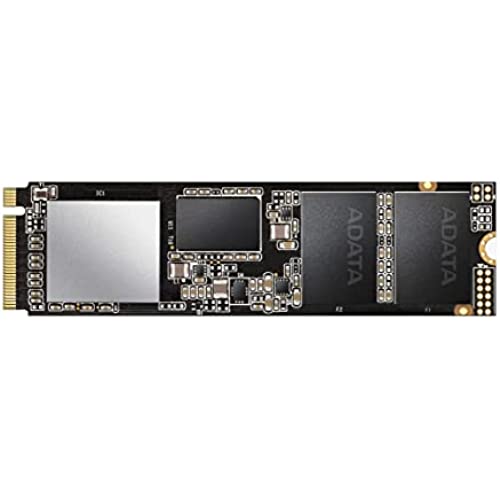
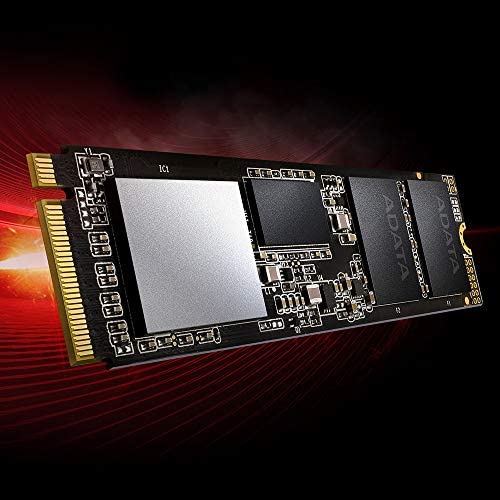
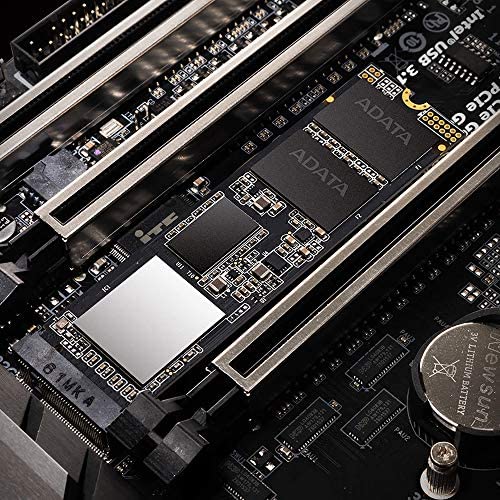
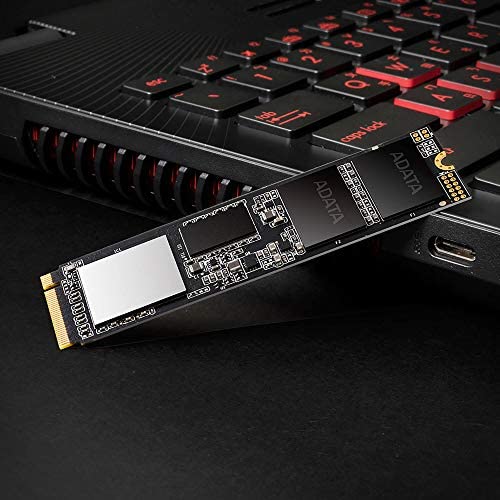
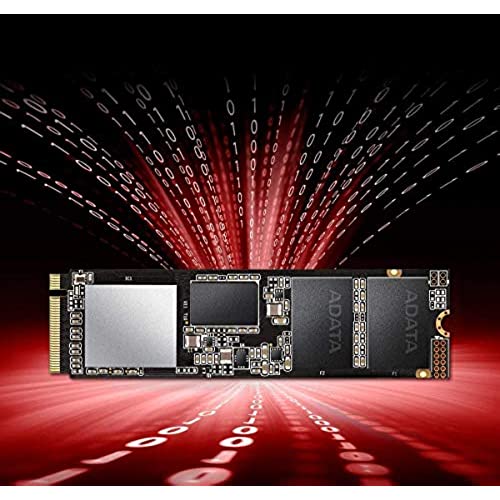







XPG SX8200 Pro 2TB 3D NAND NVMe Gen3x4 PCIe M.2 2280 Solid State Drive R/W 3500/3000MB/s SSD
-

Aviv M
> 24 hourI work in IT and have over a dozen of these as well as pretty much every other SSD on the market. As many reviews in 2020-2021 mention, they did switch over an important part to something inferior, but that happens from time to time and Im not going to focus on this, I am just reviewing this as it is regardless of how much better and cheaper it was before. SPEED -- 1/5 This is worse than a SATA SSD that you can purchase at a lower price. Fully empty, when you initially benchmark it, it barely even gets the advertised speed. This is on the most optimal conditions, and even under these, the benchmark looks like PCIe Gen3 x 2 and not Gen3 x 4. This is bad. It cant outperform something 30% cheaper that came out years ago. CONSISTENCY - 0/5 The absolute worst drive of any kind I have seen in my entire life. Writing a SEQUENTIAL test file to fill half the disk took 59 minutes, so about an average of 290MB per second, so maybe a really really old Samsung SSD from 8 years ago. This was jumping around from 2GB/s to 4GB/s for the first 15 seconds maybe just enough to cheat on a benchmark and then immediately all over the place, not even 100GB written when it went from 1GB/s to 60MB/s and 1.3GB/s then 60MB/s, 500MB/s to 60MB/s, 200-800MB/s, then maybe halfway through 100-200MB/s (this is where it was most stable if you want to call it that.) Its like using a random number generator for performance. TECHNOLOGY - 0/5 This uses SLC caching, has DRAM cache, basically a bunch of advanced methods to make it better and it performs worse than any drive Ive seen without any of that stuff. This is apparently TLC which is supposed to be superior to QLC. Basically, QLC tries to cram more. QLC is supposed to be slower, and less durable. This somehow performs about half as good as the same brand QLC which is baffling because the other model is supposed to be actually based on the XPG 8100, not the XPG 8200 PRO. As in, a 4TB version of this (double 2TB) that costs less than 2 times more even though 4TB is supposed to go up exponentially in price, performs better and more consistent as QLC than this TLC thats supposed to be the superior model of the same brand. VALUE - 0/5 This is where Ill quickly mention that the old version apparently was good, and therefore it means this is overhyped. No one bothers to update their reviews and no one bothers to research it further so they all immediately read or see something online and think this is a great value. Since XPG knows this, they basically charge way more for this model due to the high demand even though to give them some credit, XPG seems to have other better models. For some reason, and I doubt it was due to bad intentions, they had to switch the controller on these and it happened to be a bad choice. I think XPG probably ended up getting bait and switched by Silicon Motion, the supplier for the controller. Apparently this newer version thats bad is SM2262G and the old one is SM2262EN, but they did the switch over because the old version, although it performed almost on par with some of the best drives like Samsung (at a lower price, at the time) it had a shorter life. So I assume they switched over to this one to make it more reliable and ended up absolutely thrashing performance. Again, to be fair, this XPG 8200 Pro does have a good warranty, assuming they honor it properly. This is unfortunately the trade-off youll make unless you end up paying double for enterprise NVMe SSDs: the more consistently fast it is, the more likely it is to die 2-3x sooner. LIFE - 3/5 I have no reason to believe the life of this product would be lower than similarly priced NVMe SSDs. Since its TLC, itll have a better life by default versus QLC. The amount of writes you have to do to the drive to void the warranty is 1.5-3x more than competitors but I guess their strategy is to make sure you can never physically write that much to the disk by making it slow! TBW is 1280 which basically means you can write 700GB to it every day for 5 years. This means youd have to constantly write to it at about 8MB per second, or about 24MB/s assuming youre only using the computer 8 hours a day, lets say for work. This card will probably struggle to do that depending on what youre doing with it, how small the files are; the random speed test as I was constantly using it was probably about 27MB/s so barely above this threshold. So they do literally try to keep you from ever reaching that point by just making sure its slow and bad. GET ANY OTHER DRIVE. LITERALLY ANY OTHER ONE.
-

Claudete Rotary
> 24 hourI would have goven it five stars because the product arrived early which was great. It was easy to put in but, my laptop wouldnt recognize it. I ended up having to Format it before my laptop would recognize it as storage. I am happy with the drive it is working great now.
-

Mark Anthony
> 24 hourworks great in my asrock b365 pro4 motherboard,i59400f. for my system and for gamming this is the best VME i ever had, hell with sata 3, with a score of 280% in user bench mark. this thing rocks, 10 dollars for 100gigabytes x5. you cant beat it. i cant yet tell you the life span of it for i just got it, But its been 2 months and its awsome. honestly who needs Samsung. the latency diffrence you could never notice. i cant believe i got 500 gigs for under 55$. its the cheapest and fastest thing i ever had. i suppose the only question now is, and i speak for any V nand technology and thats just the life span. well if it doesnt atleast live upto its proposed lifespan of ill be back to let you know, i encourage everyone to buy this had to buy another just to get a working set. i purchased 2 cheap and very slow micro 32 gig cards, will never buy again
-

Andrew B.
> 24 hourWell, just look at the attached photo. 3500/3000 read/write as advertised (1TB model). At this price, how can anyone compete? Well see how long it lasts, but this was a fantastic replacement for my high-end laptops POS junk OEM Lite-On 128GB nVME. Note that laptop benchmarks were lower; I put this in my desktop to get a maximum figure from CrystalDisk. I did stick the heat spreader on because, in my laptop, it has to make contact with a plate for heat dissipation, and I removed the OEM crappy silicone-feeling sticky thermal pad and replaced it with AS5. Wondering if perhaps I shouldve done that on the inside of the ADATA plate too. FYI: this benchmarks much higher than the sister product, the Gammix S11, but ADATA just announced a Pro version of that one too. Well see how it is. For now, at this price (215 presently), you really cant beat it for a 1TB drive. Buy this one, not the S11 or XPG non-Pro. Update: As prices fell, I bought a second 1TB SX8200 Pro for my desktop and couldnt be happier. And as of writing this, theres even a coupon for it. Unbelievable value. Now, there are some people who say these synthetic benchmarks arent indicative of real-world performance; this is true IF you use these drives as bulk-file storage. This is how higher-density (3D/QLC/etc.) NAND flash works - its slower and backed up by a tiny amount of lower-density, much faster cache that runs out. But thats why people who need huge storage still buy several 3TB+ mechanical HDDs, right? Very few people reading this are probably trying to move terabytes of ISO or raw video files daily with their nVME drives (unless you do it as a profession, in which case money is no object, and you probably have a company NAS) - youre probably going to use it as a game and OS drive, which this is perfect for, with a few hundred/thousand tiny files being read in random orders to load up Battlefield or Overwatch or Windows, rarely being written to in solid sequential order for gigabytes upon gigabytes except during a one-time install. In other words, this is perfect as a game/OS drive, not for a large video/storage cache.
-

Patrick Garon
> 24 hourI am really Happy with this Drive, The above benchmark is not the best I have done with it, I just wanted to have an image to go with my review, this the bench was being completed while i was doing a couple small tasks, the Max I have seen it go for Seq Reads thus far is 3,200 MB/s, But getting this item on a lightening Deal for $95 was a steal! and am purchasing another one ( I will be paying a bit more since the deal is off) but this is still cheaper than my Samsung Evo Plus, and is very comparable in speeds, I copied a 60 GB game folder, from and to the same drive at 1.2 - 1.3 GB/s, I am pleased with that outcome, this is also very nice for moving videos around if you are a creator. The software they provide for free with your purchase to clone your drive was very fast and took 12 minutes, with no issues. I have seen people reviewing this saying its not as advertised, but please be sure you are seeing what item they are talking about. The 3500 /3000 Speeds are for the 1 TB drive, not for the 256 that I have seen, and be sure you have no bottlenecks on your system, and remember if you are copying from a Sata SSD to this, you are of course not going to get 3000 MB/S read and Write speeds, you will need to either copy to and from the same drive (SX8200 Pro) or if you have 2 of these drives. the limit is as fast as the slowest drive on your system you are copying to or from.
-

Mark
> 24 hourUsed it to replace my 1Tb Seagate HDD in my laptop
-

Dave
> 24 hourThis is the last component to complete a new build. The main driver of the performance I was looking for was to be able to play games on a 1440 monitor smoothly with settings on High. I was prepared to wait a few months for prices on M2 NVME drives to come down. Cyber Monday did it. Pulled the trigger and the next day this appeared on my doorstep. The Motherboard I picked (Asrock Z390 Steel Legend) came with standoffs and screws for 2 of these babies and physical installation went as expected. I agree with other posts I have seen, these screws need to be larger. A magnetic screwdriver is your friend. The drive needs to be initialized in Win10 then formatted, this went smoothly, and quickly, lol. Adata has two different cloning utilities on their website and I tried the Macrium Reflect. The other one requires a registration code from Adata which proved difficult to obtain. Cloning seemed to be successful but the system would not boot from this drive at first. I ended up doing what I should have done from the beginning, doing a fresh install of Win10 from a a USB boot stick with the existing SSD disconnected. This worked fabulously, took about ten minutes. System specs: I7 9700KF running stock speeds for now Asrock Z390 Steel Legend 16G Corsair memory running at 3200, Cas level 16 Adata ZPG 8200 Pro 1 Tb M2 NVME Adata SU750 1 Tb SSD Seagate Baracuda 2 Tb HD ASUS internal DVD writer (yea I know Im a throwback) Corsair 750 Gold 80 PSU Gigabyte 2070 Super Gaming OC GPU Corsair H100i Pro CPU cooler beQuiet Pure Base 600 case Disk benchmarks: Sequential reads only listed Seagate HD: 224Mbs Adata SSD: 548 Mbs Adata 8200 Pro M2: 3480 Mbs ! It hits all advertised speeds. Cold boot takes 20 seconds. Screen loading on games is about cut in half compared to running off the SSD. Installation of programs/games is no longer a waiting game, it just happens. My last install of a new drive was a Samsung 860 500Gb SSD. Samsung Magician actually worked to clone it but it only works on Samsung drives. I would recommend going straight to a fresh install of Windows for this drive. I did talk to Adata support during the cloning attempt. I already had around 400Gb of games on the SSD prior to the M2 install and didnt want to kill my 1 Tb download allowance from Comcast for the month. Their support person was knowledgeable and friendly and said that the Macrium software usually works. Would I buy this again? Oh yes, it is in the top tier of performance for these drives and it is finally priced right, $105 for the 1 Tb version on Cyber Monday. It affects loading of any program you use, the system is now incredibly snappy. Even just web browsing! If you are still running off of a hard drive a SSD will improve your performance quite noticeably, but now that prices are coming down finally on these M2 NVME drives, just skip the SSD entirely. I wish I could have afforded the M2 drive long ago, lol. One question remains- longevity. These critters are small and dont have a lot of surface area for heat dissipation and it was a concern. The drive will automatically throttle back if heat rises beyond a threshold value. The MB I ended up with comes with its own heat sinks for M2 drives, which reinstalled easily (although tiny screws again). Ive been keeping an eye on temp on this thing and it has not been a problem at all. It is said that heat only becomes an issue under heavy sustained writes lasting over 110 seconds or so. My heaviest use case so far was probably the Windows install. But it showed no real heat increase, the transfer being limited by the USB 3.1 speed. The M2 was just loafing along at 7% or 8% utilization. I highly recommend this drive, it is the finishing touch on this system!
-

KUMS
> 24 hourHere is the peak performance I could get with 10g file size and different block sizes. Ran on Ubuntu OS and at block level with direct IO (to avoid any filesystem caching effect). I suggest, disable filesystem cache (or do direct IO) with the benchmarking tool you are using to find the real performance. If I increase the QDEPTH, latency shoots up crazy particularly for block sizes 64k and above. With small files (5g and less) write performance is lot better for block sizes 64k and above. Here are the ball park numbers you can expect (picked best possible number with QDEPTH which showed reasonable latency). 10g file size sequential /random read for different block sizes (MB/s) ===================================================== 4k - 1344 / 882 8k - 2485 / 1246 64k - 3121 / 1815 128k - 3124 / 2014 1m - 3125 / 2586 10g file size sequential / random write for different block sizes (MB/s) ====================================================== 4k - 645 / 466 8k - 782 / 477 64k - 790 / 478 128k - 864 / 476 1m - 825 / 473 - Sustained seq write with 1m block size is about 250 MB/s
-

Aaron
> 24 hourI own the 1TB model and also the 512TB model and I plan to buy more for my upcoming builds. I have had zero problems with either of the drives. Here are the most important things I have learned in the process: 1.) Do *NOT* set your BLCK to anything other than 100MHz after installing any (not just this brand/model) M.2 drive; it will mess your drive installation up. 2.) Do not download or use XPGs version of Acronis. 3.) XPG also offers Macrium Reflect with these drives. Do download/use this software. It not only does it make cloning easy and painless, but it is a full featured software for backing up and restoring. Unlike other free softwares with drives, it does not restrict you to a drive that you bought; it will backup or restore any drive in the installed system. Especially with the 512GB drive, this is an amazing value. I paid $70 for the 512 GB drive, and the regular full version of Macrium Reflect costs about that much. To access the download, go to Adatas site (not XPG), and look for the link to Valuable software. It is something like consumer->support->download->valuable software. Not easy to find. 4.) The heatsink that comes with this drive is useless (except cosmetically). However, this drive does not really need a heatsink; it is very power efficient. 5.) If you cant find the M.2 screw in your motherboard box, look on the board itself; that is where I found mine. If you cant find it in either place, you are going to need to order a screw kit. You may want to check this before ordering any M.2 drive as none of them come with the screw. 6.) Use a magnetic screwdriver while installing your M.2 drive. You will be sorry if you dont. 7.) I got slightly better drive performance after adjusting my ring bus ratio. YMMV. 8.) There are very few ways that the speed of this drive can be felt as compared to a SATA SSD, but 3000MB/s sounds awesome, huh? 9.) Having components on only one side makes these drives good for laptop use. Drives with components on both sides dont always fit. I hope this helps.
-

juanejot
> 24 hourI ordered this drive again two years after the first time, because my storage needs on the same PCI Gen3-capable board had increased, and the price & more recent reviews on this remained competitive. I had heard in the intervening time that ADATA had switched from the SM2262EN to the SM2262G controller, potentially affecting performance; had then heard that after public backlash they had switched back to the EN (this later revision referred to as “ENG,” and functionally equivalent to “EN,” not to “G”). That said, I was unsure whether old G controllers were still in distribution channels, especially given logistics concerns over the past two years. Unfortunately, the product listing is not specific, and I didn’t think to reach out to customer service to ask the question, until after I had placed my order. The automated response said to expect a response from a person within a few days AFTER I was due to receive the part; uh oh. But luckily, I got a response by the next day after my query, assuring me the item they had coming out to me was the “EN(G)” variant, and even guiding me on how to check once I had the packaging open, likewise assuring me that if it were “G,” I could send it right back & receive the correct one in replacement. When it arrived, it was indeed the ENG variant, matching both items I had received from them in the past. This experience of getting the ENG unit may not match your own, so if concerned, I urge you to reach out BEFORE ordering! That said, the speed and temperature profile of the one I received seems comparable to the original units, and the original review (below) stands, except that it’s now only about 2/3 the price it was then; even better! — Original review from 1/2020 below: MUCH cheaper than roughly equivalent Samsung units, with little performance hit. Especially on OSes for which the NVMe driver is not optimized for raw speed (say, macOS testing with Blackmagic Disk Speed Test, as opposed to Windows testing with CrystalDiskMark), the difference is likely negligible for most workloads, for a whole lot of savings. I chose not to use the included, but flimsy heatsink sheet, in favor of the one that came with the motherboard. Using that, I’ve never topped 40°C in the slot directly below the CPU (even under loads that put the CPU up to 85°C with a good but not amazing air cooler, in a case/fan config that’s admittedly pretty good for cooling).
